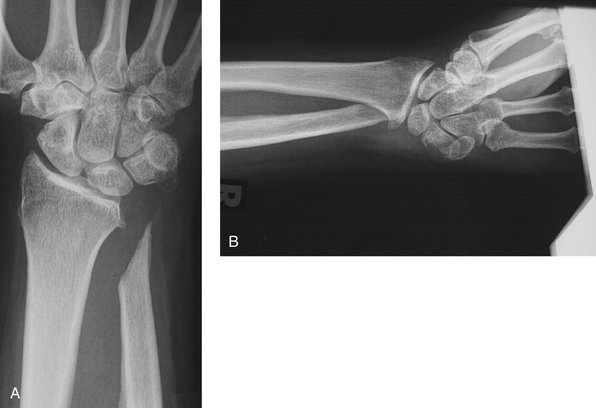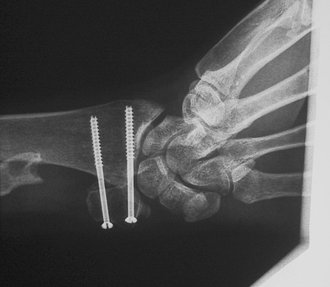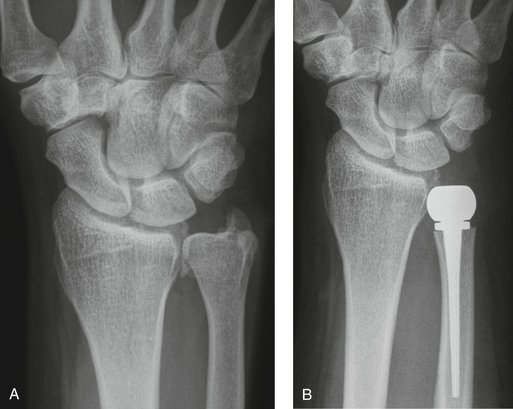CHAPTER 36 Ulnar Head Implants: Unconstrained
The ulnar head is the keystone for mobility and stability of the ulnar-sided wrist as well as the forearm. It not only is one of the joint partners creating the distal radioulnar joint (DRUJ) but also represents an integral part of the wrist joint. Biomechanically, it represents the only fixed, nonmoving anatomical structure at the wrist level. It, therefore, supplies the bony support around which the radius with the wrist and hand rotates in the DRUJ. Arthrotic destruction of the DRUJ will lead to painful limitation of forearm rotation and reduction of grip strength and therefore compromise hand function. Arthrotic derangement may be the result of intra-articular fractures of the DRUJ either with direct damage of the cartilage of the ulnar head or the sigmoid notch in comminuted fractures or secondary destruction due to intra-articular malunion of the joint line. However, the most common origin consists of the malunited extra-articular distal radius fracture. The dorsal or palmar angulation of the distal radial fragment with loss of the physiological ulnar inclination and shortening of the radius will lead to incongruity of the DRUJ and over time result in arthrotic derangement of this joint. I, therefore, consider the malunited extra-articular distal radius fracture a prearthrotic deformity of the DRUJ.1
Several salvage procedures have been described to reduce the pain and restore forearm rotation in patients with symptomatic DRUJ destruction, including ulnar head resection2–4 and the hemi-resection interposition technique.5 Partial loss of the ulnar head sacrifices the attachment of the palmar ulnocarpal ligaments and the force transfer from the radius onto the ulnar head. Loss of the ligament attachment will result in a palmar drop of the ulnar-sided wrist with a supination deformity of the hand and a dorsally prominent distal end of the ulna. In a way this is comparable to the well-described caput ulnae deformity in rheumatoid patients. The deformity does not truly represent an “instability of the distal end of the ulna” but an instability of the ulnar-sided wrist. Loss of the bony support of the radius in the DRUJ leads to radioulnar narrowing or impingement during forearm rotation and wrist loading and can radiologically be demonstrated on the transverse loading stress views described by Lees and Scheker (Fig. 36-1).6
A completely different concept to treat the painfully destroyed DRUJ consisting of fusion of the DRUJ and segment resection proximal to the ulnar head to restore forearm rotation was described by Sauvé and Kapandji in 1936.7 With this procedure the supination deformity and the instability at the DRUJ level is prevented as the attachments of the ulnopalmar ligaments and the triangular fibrocartilage complex (TFCC) remain. However, in pronation underloading of the hand the dynamic dorsal stabilizers of the radius and the wrist may not be sufficient to prevent palmar drop of the wrist and hand in relation to the distal end of the ulna, therefore leading again to a dorsally prominent distal ulnar stump. Furthermore, on transverse loading of the hand there is no anatomical structure to prevent the radius to fall onto the distal end of the ulna, resulting in radioulnar impingement (Fig. 36-2).8,9
The concept to prevent development of this instability using an ulnar head spacer in rheumatoid patients was first described by Swanson.10 This is no longer recommended because of the high failure rate of the Silastic spacer material and secondary Silastic-induced synovitis.11–15
To overcome the secondary “painful instability of the distal ulna,” several stabilizing soft tissue procedures using part of the flexor and/or the extensor carpi ulnaris tendon have been described. None of these procedures was found to reliably restore the stability or reduce symptoms in biomechanical16 or clinical17,18 studies. Wide resection of the ulna19 as well as lengthening procedures after excessive shortening of the ulna20 have been advocated but did not resolve the symptoms in my own or other surgeons’ experience.17 Considering the biomechanical and clinical shortcomings of the above-described resection procedures, Herbert developed the concept of restoring stability to the DRUJ as well as the wrist joint and the continuity of the ulna by means of an ulnar head prosthesis.
Following the development of the prosthesis a three-phase clinical study design was developed. Initially, three patients with painful instability of the wrist and forearm after resection arthroplasty were treated in 1995 with promising early results.21 The second phase consisted of a prospective multicenter study limited to another 20 patients. Because of the excellent mid-term results of these patients,22 the prosthesis was released to other surgeons. The third phase consisted of the evaluation of the long-term results, and all patients with a follow-up of more than 5 years are currently under review.
Indications
Other Indications
Primary osteoarthrosis of the DRUJ is a rare condition but represents an ideal indication for ulnar head replacement because there is no additional DRUJ pathological process that must be addressed at the time of surgery. It frequently affects middle-aged active patients who expect normal performance of the wrist and hand in their professional and private life (Fig. 36-3). The same applies for patients with a giant cell tumor of the ulnar head requiring ulnar head resection.
Another major indication for ulnar head replacement is as a revision procedure in patients with painful instability of the wrist and forearm after previous resection arthroplasties (hemi-resection or complete resection of the ulnar head) or a Sauvé-Kapandji procedure. The long-term experience with this difficult group of patients has proved that reconstruction of the DRUJ using the ulnar head prosthesis is an effective method to cure the problem. However, revision surgery is often difficult and less predictable than when the operation is carried out as a primary procedure. In patients with painful instability after a Sauvé-Kapandji procedure two options for reconstruction are available. Resection of the fusion mass and insertion of the prosthesis is recommended if either the fusion has not healed completely or the original fusion has been performed in an ulnar-positive variance situation leading to additional symptoms of ulna impaction syndrome. In all other cases a spherical head, designed by Fernandez and colleagues,23 may be used to articulate within the previously fused ulnar head after reaming of a socket into the proximal fusion mass.










